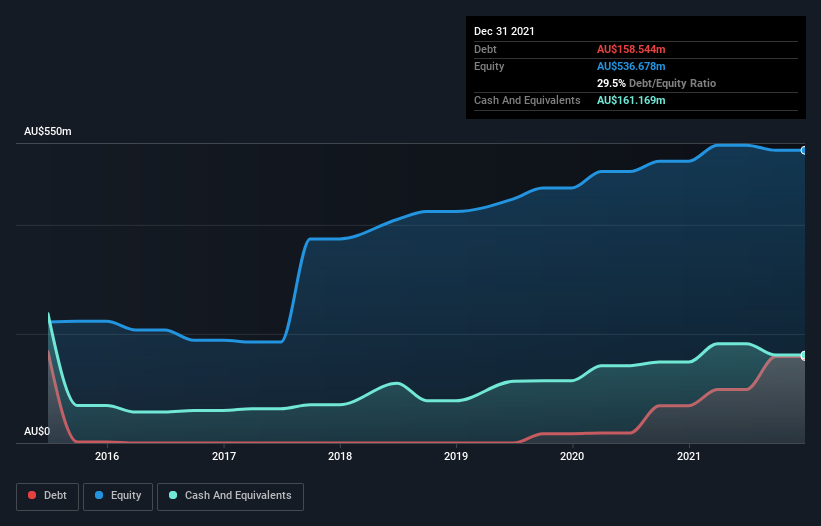Does Macmahon Holdings (ASX:MAH) Have A Healthy Balance Sheet?
Legendary fund manager Li Lu (who Charlie Munger backed) once said, 'The biggest investment risk is not the volatility of prices, but whether you will suffer a permanent loss of capital.' So it seems the smart money knows that debt - which is usually involved in bankruptcies - is a very important factor, when you assess how risky a company is. Importantly, Macmahon Holdings Limited (ASX:MAH) does carry debt. But the more important question is: how much risk is that debt creating?
When Is Debt Dangerous?
Generally speaking, debt only becomes a real problem when a company can't easily pay it off, either by raising capital or with its own cash flow. In the worst case scenario, a company can go bankrupt if it cannot pay its creditors. However, a more common (but still painful) scenario is that it has to raise new equity capital at a low price, thus permanently diluting shareholders. Having said that, the most common situation is where a company manages its debt reasonably well - and to its own advantage. The first step when considering a company's debt levels is to consider its cash and debt together.
Check out our latest analysis for Macmahon Holdings
What Is Macmahon Holdings's Debt?
The image below, which you can click on for greater detail, shows that at December 2021 Macmahon Holdings had debt of AU$158.5m, up from AU$68.3m in one year. However, it does have AU$161.2m in cash offsetting this, leading to net cash of AU$2.63m.
A Look At Macmahon Holdings' Liabilities
We can see from the most recent balance sheet that Macmahon Holdings had liabilities of AU$408.6m falling due within a year, and liabilities of AU$305.7m due beyond that. Offsetting this, it had AU$161.2m in cash and AU$278.9m in receivables that were due within 12 months. So its liabilities outweigh the sum of its cash and (near-term) receivables by AU$274.2m.
This deficit is considerable relative to its market capitalization of AU$336.2m, so it does suggest shareholders should keep an eye on Macmahon Holdings' use of debt. This suggests shareholders would be heavily diluted if the company needed to shore up its balance sheet in a hurry. While it does have liabilities worth noting, Macmahon Holdings also has more cash than debt, so we're pretty confident it can manage its debt safely.
Sadly, Macmahon Holdings's EBIT actually dropped 4.5% in the last year. If earnings continue on that decline then managing that debt will be difficult like delivering hot soup on a unicycle. When analysing debt levels, the balance sheet is the obvious place to start. But ultimately the future profitability of the business will decide if Macmahon Holdings can strengthen its balance sheet over time. So if you're focused on the future you can check out this free report showing analyst profit forecasts.
Finally, a company can only pay off debt with cold hard cash, not accounting profits. Macmahon Holdings may have net cash on the balance sheet, but it is still interesting to look at how well the business converts its earnings before interest and tax (EBIT) to free cash flow, because that will influence both its need for, and its capacity to manage debt. Over the most recent three years, Macmahon Holdings recorded free cash flow worth 77% of its EBIT, which is around normal, given free cash flow excludes interest and tax. This free cash flow puts the company in a good position to pay down debt, when appropriate.
Summing up
Although Macmahon Holdings's balance sheet isn't particularly strong, due to the total liabilities, it is clearly positive to see that it has net cash of AU$2.63m. And it impressed us with free cash flow of AU$41m, being 77% of its EBIT. So we don't have any problem with Macmahon Holdings's use of debt. The balance sheet is clearly the area to focus on when you are analysing debt. However, not all investment risk resides within the balance sheet - far from it. Case in point: We've spotted 2 warning signs for Macmahon Holdings you should be aware of.
If you're interested in investing in businesses that can grow profits without the burden of debt, then check out this free list of growing businesses that have net cash on the balance sheet.
Have feedback on this article? Concerned about the content? Get in touch with us directly. Alternatively, email editorial-team (at) simplywallst.com.
This article by Simply Wall St is general in nature. We provide commentary based on historical data and analyst forecasts only using an unbiased methodology and our articles are not intended to be financial advice. It does not constitute a recommendation to buy or sell any stock, and does not take account of your objectives, or your financial situation. We aim to bring you long-term focused analysis driven by fundamental data. Note that our analysis may not factor in the latest price-sensitive company announcements or qualitative material. Simply Wall St has no position in any stocks mentioned.

 Yahoo Finance
Yahoo Finance 
